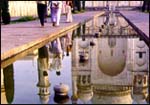

|
|
|
|
| HOME | TRAVEL | TRAVELOG | |||
 Gateway to History ... Aurangabad has some of India's finest monuments
Sanjay Singh Badnor
On my way to this historically relevant city, I barely make it to my early morning flight from the Indira Gandhi airport, New Delhi. The ideal time to visit this city and the Deccan plateau is winter, when it is wreathed in a post-monsoon green cover.
Aurangabad is located almost 410 km northeast of Bombay and is situated on the northern part of the elevated Deccan plateau in the region known as Marathwada, in the state of Maharashtra. The city, which has been inhabited since the stone ages, has a 2000-year- old recorded history of artistic activity.
Aurangabad has now become a major industrial hub, thanks to which a variety of accommodation is available. I decide to check in at Welcomgroup's Hotel Rama International, one of the best hotels in the city. Barely a few kilometres from the airport, yet close to the city centre, the Rama International was, I found, the ideal place to stay. After a bit of rest, I set off on the first of my sightseeing jaunts -- and there were to be many, given that in the neighbourhood of Aurangabad there are enough monuments, mosques, forts, temple, caves to keep a keen sightseer busy for a few months -- to Daulatabad fort, 13 km from Aurangabad.
Mohammed bin Tughlaq, that eccentric sultan of Delhi, was so impressed with this fort that he made it his capital -- Daulatabad -- The City of Fortune. He also made the entire population of Delhi walk 1,100 km to the new capital. Predictably when they arrived, their numbers were considerably diminished. Seventeen years later, when prosperity never arrived at The City of Fortune, the sultan made them march all the way back to Delhi. A proper exploration of the Daulatabad fort -- the various chambers, citadels, the labyrinth of pathways and tunnels -- would take days and would be a lesson on a very cruel period of Indian history... There are rooms where kings were imprisoned for more than a decade and finally liquidated in unmentionable ways... And a peculiar and horrific defence system for intruders -- if there were any intruders, they must have been from a very brave stock... And mosques with stolen Hindu pillars... The hill, on which the fort stands, was originally known as Devagiri or 'the hill of the gods'. As luck would have it, a long religious procession began to pour out from the fort just as I reached its base. Scores of men and women attired in traditional Maharashtrian dress added a sudden dash of colour to the grey facade.
Close to Daulatabad is the virtually grassed-over Khuldabad, the final resting place of the last great Mughal Emperor, Aurangzeb among others. A simple affair, it pales in comparison to the Taj Mahal or even to that of his own consort's tomb, the Bibi ka Maqbara. The old town of strange-domed crumbling tombs lies on the outskirts of the existing Muslim settlement and is quite forgotten. Photographs by Sanjay Singh Badnor
|
|
|
Tell us what you think of this feature
|
|
|
HOME |
NEWS |
BUSINESS |
CRICKET |
MOVIES |
CHAT
INFOTECH | TRAVEL | LIFE/STYLE | FREEDOM | FEEDBACK |
|